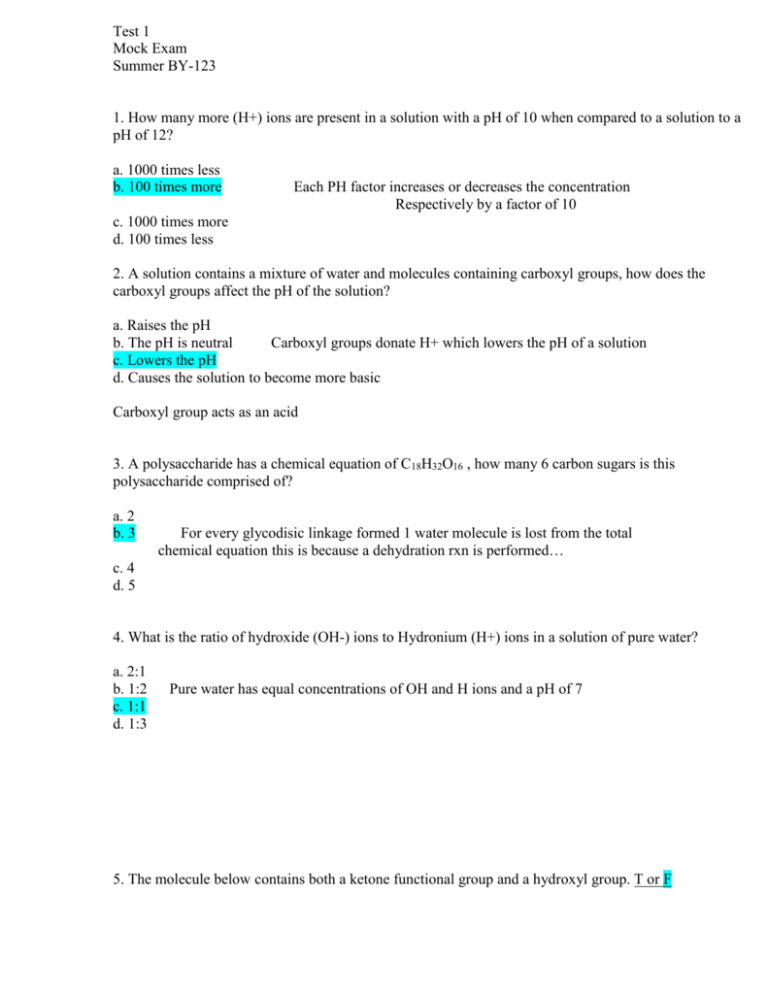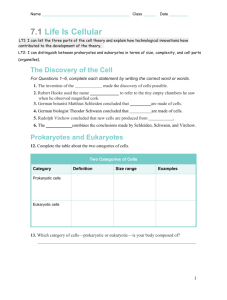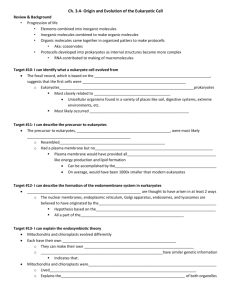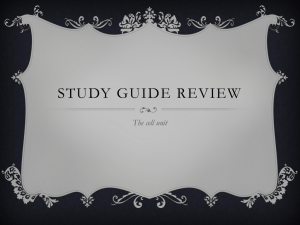Test 1 Mock Exam Summer BY-123 1. How many more (H+) ions are
advertisement

Test 1 Mock Exam Summer BY-123 1. How many more (H+) ions are present in a solution with a pH of 10 when compared to a solution to a pH of 12? a. 1000 times less b. 100 times more Each PH factor increases or decreases the concentration Respectively by a factor of 10 c. 1000 times more d. 100 times less 2. A solution contains a mixture of water and molecules containing carboxyl groups, how does the carboxyl groups affect the pH of the solution? a. Raises the pH b. The pH is neutral Carboxyl groups donate H+ which lowers the pH of a solution c. Lowers the pH d. Causes the solution to become more basic Carboxyl group acts as an acid 3. A polysaccharide has a chemical equation of C18H32O16 , how many 6 carbon sugars is this polysaccharide comprised of? a. 2 b. 3 For every glycodisic linkage formed 1 water molecule is lost from the total chemical equation this is because a dehydration rxn is performed… c. 4 d. 5 4. What is the ratio of hydroxide (OH-) ions to Hydronium (H+) ions in a solution of pure water? a. 2:1 b. 1:2 c. 1:1 d. 1:3 Pure water has equal concentrations of OH and H ions and a pH of 7 5. The molecule below contains both a ketone functional group and a hydroxyl group. T or F Ketones are found within the carbon backbone, while aldehydes are found on the terminal carbons of a carbon backbone. The structure contains multiple hydroxyl groups. Also a C=0 is a carbonyl group. 6. What kind of reaction combines 2 monosaccharaides into a disaccharide? What kind of bond is formed? a. Hydrolysis, glycosidic b. Dehydration, disulfide c. Dehydration, glycosidic d. Hydrolysis, ionic hydrolysis- breaks down, dehydration- puts togethter 7. A protein was heated to extremely high levels; you hope that this high heat did not permanently damage the protein beyond repair in hopes that the protein can be renatured. In other words, you are hoping the ____________ of the protein is not damaged. a. Secondary Structure b. Tertiary Structure Proteins cannot be salvaged (renatured) if the primary structure is messed up. c. Quaternary Structure d. None of the above – Primary Structure 8. You have discovered an unknown plant. Before looking under the microscope one would expect to find that the carbohydrates used in the cell wall for structure would contain __________. a. b. c. d. alpha linkages beta linkages None of the above Both A and B 9. Given the periodic table below, which pairs of elements would react similarly and contain similar chemical properties? a. H and Be b. N and Ar c. B and Br d. O and S 10. What property(s) of water allow it to rise from the roots to the leaves of a tree? a. Surface Tension b. Cohesion c. Adhesion d. Both B and C 11. Isotopes contain the same amount of _______ and _________ and different numbers of __________? a. Neutrons and electrons, protons b. Electrons and protons, neutrons c. Protons and neutrons, electrons d. None of the above 12. Which of the following is not a chemical property of water? a. Surface Tension b. High Heat of Vaporization c. High Specific Heat d. Doesn’t exist naturally in all 3 states of matter. 13. Ice is _______ ? a. …more dense than liquid water. Ice Floats in your glass b. …heavier than liquid water. c. …. less dense than liquid water. d. …. characterized by maximum hydrogen bonding. e. Both C and D 14.Why are noble gases considered inert? a. They only react with transition metals. b. They contain a full outer shell of valence electrons. c. They contain 8 valence electrons (except for helium which has 2). d. Both B and C 15. What kind of reaction breaks down nucleic acids? a. Dehydration Synthesis b. Condensation c. Hydrolysis reaction d. None of the Above 16. In nucleic acids which nitrogenous bases make up the Pyrimidines? a. Cytosine & Thymine b. Guanine & Cytosine c. Adenine & Thymine d. Cytosine, Thymine, & Uracil 17. Which compound is a steroid? A. B. C. D. 4 fused rings***** 18. What kind of bonds are formed between a glycerol backbone and a fatty acid chain to create triacylglyceride? a. Di-sulfide bond b. Ester linkage c. Peptide bond d. Both A and C 19. a. b. c. d. e. Compared with 31-Phosphorus, the radioactive isotope 32-Phosphorus has different atomic number one more proton one more neutron a different charge one more electron 20. What is the molecular composition of a Phospholipid and what is it’s most significant biological function? a. Glycerol back bone, 3 fatty acid chains/ biological membranes b. Phosphorus group, 2 fatty acid chains/ biological membranes c. Nitrogenous bases, 4 fused rings/ buffer d. Phosphorus group, 3 fatty acid chains/ buffer 21. What are the main function(s) of Carbohydrates? a. Long term energy storage b. Structural components of cell c. Short term energy storage d. Contractile and Motor functions e. Both B and C A is gonna be triglycerides D is gonna be proteins 22. A leg muscle from a rabbit is taken out and put under a microscope; it would be reasonable to think that a leg muscle would contain more ________ than the average group of cells. a. Cytoplasm b. Nuclei c. Mitochondria d. Endoplasmic Reticulum e. Golgi Apparatus 23. What kind of bonds are present between complementary nitrogenous bases in the Watson and Crick model of DNA? a. glycosidic linkages b. hydrogen bonds c. covalent bonds d. ionic bonds 24. All amino acids contain: a. R group b. an amino group c. carboxyl group d. All of the above e. None of the above 25. Which hierarchy of life is in the correct order from narrowest to broadest? a. Cell, Tissue, Organ System, Organ, Biosphere b. Tissue, Organ, Organ System, Ecosystem, Biosphere c. Cell, Organism, Population, Biosphere, Ecosystem d. Tissue, Organ System, Community, Population 26. An inactive enzyme is know as a(n) _________? a. Protease b. Phosphatase c. Zymogen d. Microfilament 27. Plant cells do not contain mitochondria. T or F? 28. The molecular formula for Glucose is C6H12O6. What would be the molecular formula for a polymer made by linking ten glucose molecules together by dehydration reaction a. C60 H120 O60 b. C60 H100 O50 c. C60 H111 O51 d. C60 H102 O51 29. Which element of the cytoskeleton is responsible for the separation of chromosomes during mitosis? a. Microfilaments b. Intermediate Filaments c. Microtubules d. Actin Centrioles shorten their microtubules to move them apart 30. What 2 organelles were once free-living prokaryotic cells according to the endosymbiotic hypothesis? a. Chloroplast and Cell Wall b. Mitochondria and Lysosomes c. Chloroplast and Mitochondria d. Mitochondria and Ribosomes 31. The attraction for electrons that an element possesses in a covalent bond is referred to as its _________. a. Ionization energy b. Resonance c. Electronegativity d. Electric Field 32. Ribosomal RNA is made in the __________. a. Rough Endoplasmic Reticulum b. Free Ribosomes c. Nucleolus d. Nuclear Lamina 33. Carbohydrate chains contained on the surface of the plasma membrane ______. a. Play a role in cell-cell recognition and immunity b. Are involved in cell adhesion c. Are not found on red blood cells d. A & B 34. There is no movement of particles in a solution at equilibrium. T or F Just no NET movement. 35. Imagine you are a nurse and your patient has been suffering from dehydration. What kind of solution would you put in his IV drip? a. Hypertonic solution b. Hypotonic solution c. Isotonic d. A mixture of Hypertonic and Isotonic 36. Diffusion of water is called ______ and moves from ______ to ________ solute concentrations. a. Active transport, High to Low b. Osmosis, Low to High c. Active transport, Low to High d. Osmosis, High to Low 37. A cell is placed in a solution that contains a lower concentration of NaCl in the solution than inside the cell. Which way does the water move? a. Water moves inside the cell b. Water moves inside and outside the cell at the same rate c. Water moves outside of the cell d. The cell remains the same as before. 38. An animal that lives in an extremely hot in environment, would have which adaptation(s) for their cell membrane? a. decrease in saturated phospholipids b. increase in cholesterols c. decrease in cholesterols d. decrease in unsaturated phospholipids e. Both C and D 39. Movement across a membrane of small uncharged molecules or water is a. Facilitated Diffusion b. Active transport c. Osmosis d. Simple Diffusion 40. Movement across a membrane of large molecules such as cholesterol is a. Facilitated Diffusion b. Active transport c. Bulk Transport d. Endocytosis e. C and D 41. Movement across the membrane of a molecule against its gradient co-transported with another molecule with its gradient is a. Facilitated Diffusion b. Active transport c. ATP dependent d. ATP independent e. A and D f. B and C 42. Movement across the membrane of a molecule against its gradient with the use of a transport protein is a. Facilitated Diffusion b. Active transport c. ATP dependent d. ATP independent e. A and D f. B and C 43. Which of the following is/are characteristics of life? a. adaptation b. consuming oxygen c. reproduction d. A and C e. all of the above 44. Which of the following correctly represents the order of the biological hierarchy from most complex to least complex? A) biosphere, ecosystem, population, community, organism, organ system, organ, tissue, cell, B) atom, molecule, macromolecule, organelle, cell, tissue, organ, organ system, organism C) biosphere, ecosystem, communities, population, organism, organ system, organ, tissue, cell D) population, organism, tissue, organ, cell, macromolecule, organelle E) biosphere, community, population, organism, cell, tissue, molecule 45. True or false: All organisms interact with both abiotic and biotic factors. 46. A man’s anterior pituitary gland produces luteinizing hormone, which by a series of events triggers the production of testosterone. Testosterone then goes to the anterior pituitary gland and decreases the production of luteinizing hormone. This is an example of a A) positive feedback system B) negative feedback system C) systems biology D) A and B E) none of the above. 47. Which of the following is not true? A) Covalent bonds are always the result of equal sharing of electrons. B) In an ionic bond, one atom donates its electrons to another. C) Weak bonds are interactions between atoms on different molecules. D) Hydrogen bonds are a force of attraction between a hydrogen that is covalently bonded to an electronegative atom and an electronegative atom outside of the molecule. E) All of the above are true. 48. 14. How many grams of sucrose (table sugar) would one need to make 1.5 L of a 1 M solution of the molecule? (MW of sucrose = 342.3 g/mol) A) 342.3 B) 1.5 C) 513.4 D) 684.6 E) 228.2 49. One of the buffers that contribute to pH stability in human blood is carbonic acid (H2CO3). Carbonic acid is a weak acid that dissociates into a bicarbonate ion (HCO3-) and a hydrogen ion (H+). Thus, H2CO3 ⇔ HCO3- + H+ If the pH of the blood drops, one would expect A) a decrease in the concentration of H2CO3 and an increase in the concentration of HCO3-. B) the concentration of hydroxide ion (OH-) to increase. C) the concentration of bicarbonate ion (HCO3-) to increase. D) the HCO3- to act as a base and remove excess H+ with the formation of H2CO3. E) the HCO3- to act as an acid and remove excess H+ with the formation of H2CO3. 50. What functional groups does the molecule below have? A) hydroxyl group B) carbonyl group C) ketone group D) methyl group E) A, B, and C 51. Why can we digest starch but not cellulose? A) Because starch is a sugar and cellulose is not. B) Because starch is made out of glucose and cellulose is made out of fructose. C) Because strands of cellulose are would into microfibrils. D) Because starch is made out of alpha glucose and cellulose is made out of beta glucose. E) Because starch is a monomer and cellulose is a polymer. 52. What is the following compound? A) a lipid B) a sugar C) a steroid D) A and C E) All of the above 53. Which of the following is paired correctly? A) carbohydrates- glycosidic linkages B) proteins- peptide bonds C) lipids- ester linkages D) nucleic acids- phosphodiester bonds E) All of the above 54. Which of the following is not true regarding nucleic acids? A) DNA has deoxyribose sugar and RNA has ribose sugar B) a nucleic acid is made out of a nitrogenous base, a sugar, and a phosphate group C) the two strands of DNA are held together by covalent bonding D) The two strands of DNA run antiparallel, 5’->3’ and 3’->5’ E) There always must be one purine and one pyrimidine in a complementary pair 55. When biologists wish to study the internal ultrastructure of cells, they most likely would use A) a light microscope. B) a scanning electron microscope. C) a transmission electronic microscope. D) A and C only E) A, B, and C 56. Which of the following is not a function of the Golgi apparatus? A) receiving products from the endoplasmic reticulum B) modifying molecules and macromolecules C) sending products to the plasma membrane or to other organelles D) putting chemical identifiers onto products to let the cell know where the product needs to go E) making sugars from scratch 57. Which of the following is not true regarding mitochondria? A) Mitochondria provide surface area for protein synthesis. B) Mitochondria have an inner and outer membrane, as well as an intermembrane space. C) Mitochondria have both cristae and a matrix. D) Mitochondria’s main function is to make ATP. E) Mitochondria have ribosomes and DNA in their matrix. 58. Of the following, which is probably the most common route for membrane flow in the endomembrane system? A) Golgi → lysosome → ER → plasma membrane B) mitochondria → plasma membrane → nuclear envelope → smooth ER C) nuclear envelope → lysosome → Golgi → plasma membrane D) rough ER → vesicles → Golgi → vesicles → plasma membrane E) ER → chloroplasts → mitochondrion → cell membrane 59. Which of the following does not involve R group interactions in proteins? A) Primary structure B) Secondary structure C) Tertiary structure D) Quaternary structure E) Both A and B.









